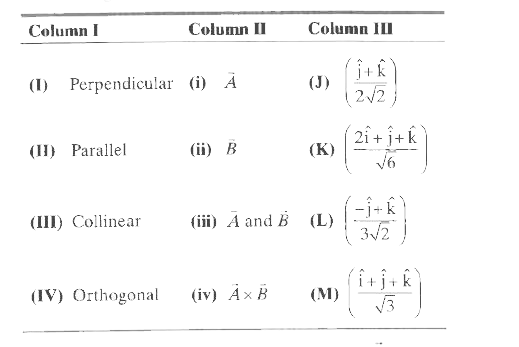If →A=2ˆi+ˆj+ˆkand→B=ˆi+ˆj+ˆk are the two vectors, match the following answer the questions by appropriately matching the information given in the three columns of the following table:

Which vector represents the direction of →A×→B?
(II)(iv)(K)
(I)(ii)(J)
(IV)(i)(M)
(I)(iv)(L)
The correct Answer is:D
Step by step video, text & image solution for If vecA = 2 hati + hatj + hatk and vecB = hati + hatj + hatk are the two vectors, match the following answer the questions by appropriately matching the information given in the three columns of the following table: Which vector represents the direction of vecA xx vecB? by Physics experts to help you in doubts & scoring excellent marks in Class 12 exams.
Updated on:21/07/2023Topper's Solved these Questions
- VECTORS BOOK - RESNICK AND HALLIDAYCHAPTER - VECTORS EXERCISE - PROBLEMS
34 Videos
- UNITS AND MEASUREMENT BOOK - RESNICK AND HALLIDAYCHAPTER - UNITS AND MEASUREMENT EXERCISE - PRACTICE QUESTIONS (MATRIX-MATCH)
11 Videos
- WAVE - IIBOOK - RESNICK AND HALLIDAYCHAPTER - WAVE - IIEXERCISE - PRACTICE QUESTIONS (INTEGER TYPE)
5 Videos
Similar Questions
Knowledge Check
If →A=2ˆi+ˆj+ˆkand→B=ˆi+ˆj+ˆk are the two vectors, match the following answer the questions by appropriately matching the information given in the three columns of the following table:

Which option represents a vector orthogonal to →A×→B ?A(IV)(ii)(M)B(II)(ii)(J)C(I)(i)(L)D(III)(iv)(K)If →A=2ˆi+ˆj+ˆkand→B=ˆi+ˆj+ˆk are the two vectors, match the following answer the questions by appropriately matching the information given in the three columns of the following table:

The correct alternative for a collinear vector to →A isA(III)(iv)(L)B(II)(ii)(K)C(IV)(i)(J)D(I)(iii)(M)If →A=2ˆi+ˆj+ˆkand→B=ˆi+ˆj+ˆk are two vectores, then the unit vector is
Aperpendicular to →Ais(−ˆj+ˆk√2).Bparallel to →Ais(2ˆi+ˆj+ˆk√6).Cperpendicular to →Ais(−ˆj+ˆk√2).Dparallel to →Ais(ˆi+ˆj+ˆk√3).
→A=4ˆi+4ˆj−4ˆk and →B=3ˆi+ˆj+4ˆk, then angle between vectors →A and →B is
View SolutionIf →A=2ˆi+ˆj+ˆkand→B=ˆi+ˆj+ˆk are two vectores, then the unit vector is
View SolutionGiven : →A=2ˆi−ˆj+2ˆk and →B=−ˆi−ˆj+ˆk. The unit vector of →A−→B is
View SolutionIf →A=ˆi+2ˆj−ˆk,→B=−ˆi+ˆj−2ˆk , then angle between →Aand→B is
View SolutionIf →a=2ˆi−3ˆkand→b=ˆi+4ˆj−2ˆk then →a×→b is
View Solution
